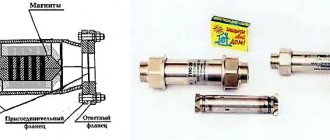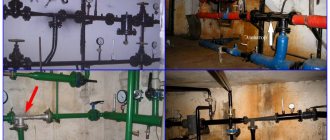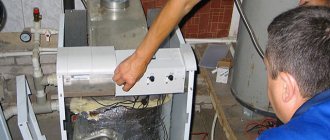Home/Water supply and sanitation/Replacement of risers in apartment buildings
Despite the fact that most residents are the owners of their apartments and pay for general building needs on a monthly basis, direct replacement of risers and other water supply elements is carried out by representatives of the management company (MC). Their actions are based on the regulatory framework of the laws of the Russian Federation. However, not many apartment owners know their rights if it is necessary to replace common communication elements located in their apartments.
The solution to replacing risers in an apartment building, the identification of responsible persons and the rules of behavior in conflict situations will be given below.
Normative base
The regulatory framework for the replacement and repair of the water supply system is regulated by:
- rules for the maintenance of property located in the common possession of the apartment building (RF RF No. 491 dated 08/13/20016);
- standards for the technical use of housing stock (Resolution of the State Construction Committee of the Russian Federation dated September 27, 2003 No. 170);
- methodological manual for the operation, maintenance and repair of housing stock MKD 2-04.2004.
Who should change risers in an apartment building?
It is a mistake to believe that if the common water risers are used by the residents of the apartments of an apartment building, then the responsibility for replacing them rests entirely with them. Ignorance of the regulatory framework of the Housing Code leads to unnecessary waste of money from the pockets of owners.
Attention
Decree of the Russian Federation No. 354, Article 149 (dated May 6, 2011) and Article 161 of the Housing Code of the Russian Federation state that repairs, as well as complete replacement of risers in an apartment building, are the responsibility of the Management Company assigned to a specific building.
Every month, each apartment owner receives a receipt for utility bills, which contains the column “maintenance and repairs.” For those funds that come from residents from paying receipts, in particular for maintenance and repairs, all preventive and repair work must be carried out.
Consequently, in the event of a pipe break or other damage to the riser, the housing office is obliged to carry out repair work without charging residents (the reverse action is illegal).
What difficulties with the law may arise if you carry out the work yourself?
The legislation of the Russian Federation does not prohibit apartment residents from changing the risers located in their premises. However, according to Articles 44 and 46 of the Housing Code, they are considered common property, and any changes without approval are considered a violation of property rights. In practice, there will be no problems if the system operates reliably and no one has any complaints.
Everything changes when a defect is discovered on the installed pipe. Further, serious problems and punishments will appear:
- the management company will refuse to repair the system with an unauthorized change;
- If neighbors are flooded, the blame will fall entirely on the citizen who committed the unauthorized action.
The owner, represented by the management company, may demand new repairs at the expense of the tenant. For example, if you install a plastic riser without authorization, you may be required to return the metal pipe.
Replacement standards
According to the standards for replacing risers in an apartment building, they must be replaced in two cases:
- Expiration of the operational life of the metal structure.
- Complete renovation of the apartment's bathroom.
Living conditions provide for 2 modes of pipe replacement:
- planned - when the time for replacement has approached;
- emergency - when the integrity of the pipe has been damaged and a leak has formed.
IMPORTANT
The warranty period for pipes in apartment buildings is at least 25 years. Even if after this period the structure is intact without leaks, the riser still needs to be replaced.
Increasingly, cast iron pipes are being replaced with polypropylene ones. This is due to a number of advantages of the material:
- efficiency;
- ease;
- strength;
- environmental safety;
- resistance to deformation from thermal effects;
- resistance to corrosion and other influences;
- sliding structure of the internal walls, which prevents plaque formation;
- long service life: from 50 to 100 years.
Metal pipeline
This is a traditional heating material. The operating temperature of the carrier in apartments can reach 110 C. In practice, this is quite rare, but 75–95 C is a common occurrence. Metal copes with this task perfectly.
Stainless steel – combining water and iron is not considered a good idea. Metal is susceptible to corrosion, and therefore unusual steel is used for communication systems - stainless or galvanized. The material has a lot of advantages and some disadvantages.
- Steel is very durable. 50 years is the typical lifespan of the system.
- Stainless steel is not subject to corrosion. In addition to the fact that this ensures durability, this property also determines the relative smoothness of the internal walls: the working diameter changes less over time, since salt and sediment are deposited to a lesser extent.
- Steel products can withstand not only high temperatures, but also pressure surges, which often occurs in a city apartment.
- Installation of heating risers made of steel pipes requires welding. The main difficulty is that bent structures are not possible here.
- The steel is quite heavy, so the system itself is more difficult to maintain and its assembly is not easy.
Copper piping is the most expensive option available. There are many advantages to this.
- This system is the most durable and reliable.
- Complete chemical inertness - copper does not interact with salts, alkalis, or acids.
- The working diameter of the heating riser pipe does not change over time, since the copper walls remain completely smooth.
Copper is a very ductile metal, installation is done by soldering, and bent structures do not cause any particular difficulties. And since metal is very decorative, there is no need to disguise pipes made from it.
It is not recommended to use galvanized steel for heating: salts and various active additives added to hot water quickly destroy the zinc coating. And without protection, steel quickly deteriorates.
Plastic pipeline: polypropylene and metal-plastic
Not all plastic can be used. Thus, ordinary polyethylene cannot withstand not only high pressure, but also the average operating temperature of the carrier.
Cross-linked polyethylene is a relatively new material, the main advantage of which is its resistance to high temperatures - it can withstand 95 C.
- The material is not subject to any type of corrosion. Moreover, it is resistant even to direct sunlight, which is usually no different from plastic.
- Chemical inertness is characteristic of all polymers.
- The ideal smoothness of the walls ensures that the diameter remains unchanged - no sedimentation until the end of its service life.
Light weight - installation is very simple.
A heating riser made of polypropylene pipes is the most affordable design. Moreover, it has all the other advantages.
- The polypropylene structure is connected by welding to fittings. The seams here are no less durable than the material itself.
- Temperature resistance and chemical inertness are no less than that of cross-linked polyethylene.
- Resistance to water hammer.
- The disadvantages inherent in polypropylene products include a high coefficient of thermal expansion. When installing the system, it is necessary to provide compensation loops and non-rigid fastening.
Metal-plastic pipes for heating risers do not have this drawback. This is a multilayer product, the role of the middle layer in which is played by a thin aluminum sheet - solid or profiled. It not only provides the pipeline with additional strength, but also compensates for thermal expansion.
- Simpler installation - connection to fittings of the appropriate diameter and the absence of compensation devices.
- Chemical inertness and resistance to high temperatures.
- Thanks to the metal layer, oxygen does not destroy the walls; the metal-plastic riser is much more durable.
- The construction cost will be higher.
How to disguise heating riser pipes is a fairly simple task. Metal-plastic products can be hidden in the wall, disguised in decorative boxes, or even decorated. In the photo you can see such an example.
What is included in replacing risers in an apartment building?
The process of replacing a riser in an apartment building is the direct removal of the old structure for a new one. However, this is not all that is included in the concept of “replacing a riser in an apartment building.”
Attention
First, you need to contact the management company and write an application to replace the pipe. The applicant will receive a satisfactory answer if the document is drawn up correctly and the facts supporting it do not raise doubts.
On the appointed day, representatives of the management company turn off the water in the risers and drain the remaining water. After this, craftsmen come from the management company or organization with which the management company has entered into an agreement. They carry out all the necessary procedures for replacing a faulty riser pipe in an apartment building.
- The master uses a grinder to cut out old pipes.
- Makes markings for new branches.
- New pipeline structures are being installed.
- They run water to check the tightness of all joints of the new riser.
By law, all necessary elements of the communication system that need to be replaced are delivered to the owner’s apartment. However, situations are not uncommon when the tenant himself, in whose apartment the installation is to be carried out, pays for all consumables and the element of the new pipe itself. By law, all expenses of the owner must be included in the payment of the receipt for the maintenance of common property for the next month.
Rules for installation work
Work can only begin when all water has been drained from the risers and heating system. To do this, you will need to close the valves in the basement of your house. If you did everything correctly, then when you open the water drain valve in your apartment, you will hear a characteristic noise from the air inside the system and all the remaining coolant will leave the heating system. Now you can start replacing the pipes in the apartment. The installation sequence will be described taking into account the fact that you have chosen a galvanized pipe.
Thread cutting. At the very beginning, we cut the riser using a hacksaw or a small grinder with a metal disc installed. If you are going to replace all the risers along with the heating system, then you cannot do without a preliminary agreement on joint work. The order of cutting threads using a die must be done in the following sequence. First of all, you will need to remove a small chamfer on the pipe so that you can install the die without any problems. If the pipe has been painted, be sure to remove the paint before cutting the thread. Having installed the die in the holder, we begin to slowly scroll it with little effort. It is recommended to make two or three turns forward and then half a turn back. The pipe should be held with a wrench to prevent it from rotating with the die. The thread length must be at least five turns so that the fitting or coupling can be connected to the pipe without problems.
Installation of liners and risers
When working with galvanized pipe, special attention must be paid to sizing. When installing fittings made of brass or cast iron, you should not be too zealous, as this is a very fragile material
You will definitely need to use a winder. This can be a special sanitary linen or polymer material. To prevent it from fading during operation, it is recommended to apply a small layer of silicone sealant, drying oil or paint to the threads. If you plan to install shut-off valves for each heating device, which will allow, if necessary, to replace it without shutting down the entire heating system, then this must be done using a jumper. It is best to use modern ball valves.
Pressure testing of the heating system and its startup. After completing the work, you will need to remove air from the system and check the pressure. How can this be done at home? To do this, you will need to close the valves on the heating devices. Then, closing the water outlet, slowly fill the system to avoid possible water hammer. As soon as the noise of incoming water stops, open the second valve and you can begin inspecting the heating system for possible leaks. Excess air can be vented using a Mayevsky tap on the upper floors.
https://youtube.com/watch?v=B1XuHj04M5o
Thus, if everything is done correctly and consistently, you can replace the heating pipes in the apartment yourself, without the help of a specialist. However, if you still decide to turn to the masters of their craft, we recommend this company!
Step-by-step instructions for replacing risers in an apartment building
A break in the water riser in one apartment requires its immediate replacement. Before carrying out repair work, the owner of an “emergency” apartment must discuss this action with the neighbors of the upper and lower floors. The fact is that the pipes are in a worn state along their entire length, despite the fact that the breakthrough occurred in a certain place. And for reliability, they should be replaced completely, in all apartments. If the neighbors disagree, the installation of a common water supply channel will be carried out only in one apartment.
The next step is to contact the Criminal Code. Their powers include shutting off the riser and draining the water. Next, complete or partial (in a separate apartment) installation of pipes takes place.
According to VSN 58-88 (r) “On the organization and implementation of reconstruction, repair and maintenance of buildings, public utility and social-cultural facilities,” planned replacement of water supply systems should be carried out every 25-30 years. Repair work is carried out inside privatized and non-privatized apartments, as well as in basements and entrances.
What to do if a radiator section (plate radiator) is damaged
Before performing this type of work, the first step is to turn off the heating system. Next you need to reset the riser system and disconnect the radiator.
Attention! Before removing the radiator, place some container under it, since there will still be water in the riser.
We disconnect the damaged area with a special radiator wrench and attach a new nipple.
We connect the heating system and start the risers.
If the plate radiator is damaged, you must, in the same way as in the previous case, turn off the heating and reset the riser system. Next, we clean and degrease the leak area, apply a special cold welding mixture to the area (which is an adhesive with a high degree of plasticity, made on the basis of epoxy resin), wait for it to harden and turn on the heating.
Replacing a sewer riser
The sewer riser belongs to the common property of the house, even though it passes through a private apartment (according to Article 290 of the Civil Code). Also, the RF PP No. 491 clause 5 dated 08/13/2006 states: “... the common property includes the drainage system, that is, the sewerage system...”.
Consequently, the management company is responsible for the installation and repair work of the sewer riser in an apartment building. For all the necessary consumables that will be required during the replacement process, as well as for the repair itself, apartment residents pay for it, paying monthly sums of money for receipts with the column “maintenance and repair of housing.”
IMPORTANT
On the day the sewer riser is replaced, the apartment owner does not have to pay anything.
But, if previously the owner of the apartment independently replaced the sewer pipe, and this fact is proven, then the owner is obliged to fully pay for the subsequent installation of this element of the communication system.
Before starting repairs to the sewer riser of an apartment building, a resident must:
- Visit the management company and leave an application for replacement of the emergency element.
- Draw up a report with a representative of the service organization, which will describe the condition of the sewer riser and (recommended) attach a photo.
- Specify the date and time of the work to be carried out, and notify neighbors about it in a timely manner.
- Determine the material of the structure that will be installed in place of the old one, as well as some nuances.
At the appointed time, repairmen come and carry out all the necessary actions to replace the sewer riser.
For your information
Upon completion, a “Certificate of Work Completed” is drawn up between the management company and the repair organization. The owner of the apartment should also keep a copy of this act.
Payment for replacement
The answer to the question regarding payment for replacing a riser in an apartment building is contained in Government Decree of the Russian Federation No. 491 dated August 13, 2006. The document determines what is common property, who is responsible for its maintenance and accordingly pays for its repair and replacement.
According to PP No. 491 and its section “Rules for maintaining the property of an apartment building,” each apartment owner pays for the maintenance and repair of all communications in the building. The same information is contained in Article 158 of the Housing Code of the Russian Federation “Expenses of owners of premises in an apartment building”: all owners of apartments in apartment buildings are involved in the costs of maintaining and repairing common property.
Thus, all costs for replacing the water supply riser in an apartment building are paid by the housing and communal services from the funds that all apartment owners contribute monthly, depositing money for receipts for the maintenance of common property.
How to replace heating batteries in an apartment without breaking the law
Among the questions I have been frequently asked lately is this: “does the owner of an apartment have the right to independently replace the heating batteries in it, without approvals and permits?”
As practice shows, most citizens change heating radiators (heating devices) in their apartments on their own, without asking or notifying anyone, and accordingly without receiving any permission to do so. This is partly because in this regard there is a widespread misconception among citizens that the owner has the right to do whatever he pleases in his apartment. At the same time, the elementary reluctance of organizations serving apartment buildings to conduct periodic inspections of residential premises in apartment buildings also plays a role. All together this leads to the current situation in general. However, you still need to obtain permission to replace heating batteries. And in some cases, replacing heating batteries may even turn out to be a refurbishment of the living space, with all the ensuing problems. Otherwise, citizens who unauthorizedly replaced heating devices bear the risk of liability for their actions. Which? This can be seen below. But first, let's talk about how to comply with the law.
According to Part 1 of Article 25 of the Housing Code of the Russian Federation, “Reconstruction of a residential premises is the installation, replacement or transfer of utility networks, sanitary, electrical or other equipment that requires changes to the technical passport of the residential premises .” (All quotations below are in italics). Thus, if heating radiators are noted in your technical passport for the apartment, then replacing them, not to mention moving them to another place, will be a reconstruction. And the reconstruction of residential premises, according to Part 1 of Article 26 of the Housing Code of the Russian Federation, “is carried out in compliance with the requirements of the law in agreement with the local government body on the basis of a decision made by it.”
To obtain approval in this case, you must provide the following documents to the local administration:
- statement;
- title documents for the residential premises being converted (originals or notarized copies);
- a project for the reconstruction of the residential premises being rebuilt, prepared and executed in accordance with the established procedure;
- technical passport of the residential premises being converted;
- if the apartment is not owned, but is used under a social tenancy agreement, then the consent in writing of all members of the tenant’s family (including temporarily absent members of the tenant’s family) will also be required;
- if the apartment is an architectural, historical or cultural monument or is located in a house that is an architectural, historical or cultural monument, then a conclusion from the body for the protection of architectural, historical and cultural monuments will be required on the admissibility of reconstructing the residential premises.
You don’t have to provide a technical passport and the conclusion of the body for the protection of architectural, historical and cultural monuments - in this case, the local administration itself will request them from the authorized bodies, although in this case you will lose a lot of time. It is not required to provide title documents for the apartment if the ownership of it is registered in the Unified State Register of Rights to Real Estate and Transactions with It (justice).
The decision to approve or refuse approval must be made no later than forty-five days from the date of submission of documents by the applicant. Approval is the basis for the reconstruction of residential premises. Refusal of approval can be appealed to the court.
The completion of the reconstruction of the residential premises is confirmed by an act of the acceptance committee.
The reconstruction carried out in the absence of approval will be unauthorized, for which sanctions are provided. Article 7.21. The Code of the Russian Federation on Administrative Offences, provides for administrative liability for unauthorized reconstruction - an administrative fine for citizens in the amount of one thousand to one thousand five hundred rubles. At the same time, the owner or tenant of an apartment who has unauthorizedly replaced the heating batteries in his apartment will be required to return everything to its previous condition within the time period established by the administration. If this does not happen, then the court, based on the administration’s claim, may decide:
- in relation to the owner of the apartment - on the sale of such residential premises at public auction with payment to the owner of the proceeds from the sale of such residential premises minus the costs of executing a court decision with the imposition on the new owner of such residential premises of the obligation to bring it to its previous condition.
- in relation to the tenant of an apartment under a social tenancy agreement - on the termination of this agreement with the imposition on the owner of such residential premises, who was the lessor under the specified agreement, of the obligation to bring such residential premises to their previous condition - Article 29 of the Housing Code of the Russian Federation.
You can try to legitimize unauthorized reconstruction in court - according to Part 4 of Article 29 of the Housing Code of the Russian Federation, “based on a court decision, residential premises can be preserved in a rebuilt and (or) redesigned state, if this does not violate the rights and legitimate interests of citizens or does not create a threat their life or health." However, in this case, everything will depend on the conclusion of a forensic technical examination, which will not necessarily be in your favor, since there are certain technical standards that cannot be violated.
This position is confirmed by judicial practice. For example, in the Ruling of the Supreme Court of the Russian Federation dated November 24, 2009, N KAS09-547, the Supreme Court indicated that “ The heating elements of the heating system (radiators) located in apartments, which have disconnecting devices located on branches branched from the risers of the intra-house heating system, serve one apartment, can be dismantled by the owner after receiving permission to renovate the residential premises in the prescribed manner (Article 26 of the Housing Code of the Russian Federation).”
In a decision dated September 22, 2009 N GKPI09-725, the Supreme Court indicated that “The heating elements of the heating system (radiators) located in apartments, having disconnecting devices located on branches from the risers of the intra-house heating system, serve only one apartment and can be dismantled by the owner after receiving permission to reconstruct the residential premises (Article 26 of the Housing Code of the Russian Federation).”
All of the above, as I already said, concerns the replacement of heating batteries, if they are noted in your technical passport for the apartment, and thus fall under the concept of “reconstruction”.
If your technical passport for the apartment does not include heating batteries, then replacing them will not constitute a conversion. However, do not rush to rejoice - there are also some nuances here, and you will still have to obtain permission to replace heating batteries.
According to the Decree of the State Construction Committee of the Russian Federation No. 170 dated September 27, 2003. which approved the Rules and Standards for the Technical Operation of the Housing Stock, these rules define the rules for the operation, major repairs and reconstruction of housing and communal services, ensuring the safety and maintenance of the housing stock, technical inventory and are mandatory for execution by executive authorities of the constituent entities of the Russian Federation, state control bodies and supervision by local governments.
According to clause 1.1. Rules, “these Rules and Standards for the Technical Operation of the Housing Stock determine the requirements and procedure for maintenance and repair of the housing stock in order to: ensure the safety of the housing stock of all forms of ownership .”
According to clause 1.2. Rules, the housing stock is defined as the totality of all residential premises, regardless of ownership, including residential buildings and apartments.
According to clause 1.7.1. Rules, “Refurbishment of residential and non-residential premises in residential buildings is permitted after obtaining the appropriate permits in the prescribed manner. Re-equipment of residential premises may include: installation of household electric stoves instead of gas stoves or kitchen hearths, relocation of heating plumbing and gas appliances, installation and re-equipment of existing toilets, bathrooms, laying new or replacing existing inlet and outlet pipelines, electrical networks and devices for installation of shower cabins, Jacuzzis, high-power washing machines and other new generation plumbing and household appliances.”
According to paragraphs 5.2.5., 5.2.8 of the Rules, “It is not allowed to increase the surface or number of heating devices without special permission from the housing maintenance organization.” “ During repairs , pipelines, shut-off and control valves, air outlets and other equipment that have become unusable must be replaced in accordance with the project or recommendations of a specialized organization, taking into account the current level of manufactured equipment.”
As you can see, in order to “simply” replace your heating batteries in your apartment, you still need permission from the management organization. Moreover, these rules, paragraph 3.1.1., directly require management organizations to conduct periodic inspections in apartments of all forms of ownership, which, of course, does not happen in practice. “ Engineering and technical workers of housing maintenance organizations, during periodic inspections of residential and utility premises and adjustments of engineering equipment, must pay attention to the technical condition of enclosing structures and equipment, temperature and humidity conditions and sanitary conditions in the premises.”
According to paragraph 35 of the Rules for the provision of utility services to owners and users of premises in apartment buildings and residential buildings, approved by Decree of the Government of the Russian Federation No. 354 of May 6, 2011, “The consumer does not have the right: c ) to arbitrarily dismantle or turn off the heating elements provided for by the design and (or) technical documentation for an apartment or residential building, to unauthorizedly increase the heating surfaces of heating devices installed in a residential building beyond the parameters provided for in the design and (or) technical documentation for an apartment or residential building.”
However, the ignoring by management organizations of their direct responsibilities to inspect citizens’ apartments for the condition of engineering equipment (the same heating devices), as well as regulations by citizens who voluntarily change the heating devices in their apartments at their own discretion, does not mean at all that these legal norms do not are working. They work, and how!
As an example, I will cite an interesting judicial act - the Appeal Ruling of the Novosibirsk Regional Court dated May 13, 2014 in case No. 33-4199/2014. For those who do not understand the difference between the courts of the first and second (appellate) instances, I will say that this judicial act, in its essence, is a model for resolving a specific dispute for all local courts, and local courts will be guided by the arguments set out in it.
The situation discussed in this judicial act arose due to the fact that a citizen living in one of the apartments in an apartment building arbitrarily replaced the heating battery in his apartment: a convector-type device with a cast-iron heating device. Due to excessive pressure in the heating system, the replacement battery, which was not designed for such pressure, burst and water flooded the apartment below, seriously damaging the property there. The affected residents filed a claim for compensation for damages against the owner of the superior apartment, who arbitrarily replaced the heating battery, as well as against the management company, which, according to the plaintiffs: “improperly carried out maintenance of the engineering equipment inside the building and prepared it for the winter period, which was the cause of the accident and the damage,” considering both of them to be the culprits of the incident.
Objecting to the claim, the management company indicated that the citizen was to blame for the incident, who unauthorizedly installed a cast-iron radiator, without making changes to the technical documentation of the house, which provided for convector heating, in which the pressure cannot exceed 10 kgf/cm. sq.: “The infliction of property damage to the plaintiff occurred due to the defendant’s unauthorized replacement of a convector-type device with a cast-iron heating device, and not due to improper performance by the management organization of its duties regarding the maintenance of the common property of the apartment building. The management company is responsible for maintaining only those elements of the heating system that are part of the common property. The management company is not responsible for damage caused as a result of improper maintenance of property belonging to the owners of the premises.”
Objecting to the claim, a citizen who unauthorizedly replaced a heating device in his apartment indicated that the employees of the management organization were to blame for the incident, who, after receiving a telephone message from OAO NGTE about work at Central Heating Station-10, that hydraulic tests would be carried out, did not the valves of the pipeline at the inlet and outlet of the heating system of the house were closed, and as a result of this, a water hammer occurred in the system, which resulted in the failure of its heating battery. Also, according to a citizen who unauthorizedly replaced a heating device in his apartment, the manufacturer of the replaced heating battery, Chelyabinsk, is to blame for what happened.
Having considered the dispute, the court came to the following conclusions:
1. The cause of the flooding is a leak in the heating unit.
2. The management of an apartment building is carried out by a management company, and therefore, based on the general requirements of the law and the submitted copy of the apartment building management agreement, it follows that the management organization, for a fee, undertakes to provide services and perform work on the management, maintenance and repair of common property in an apartment building, to provide utilities and housing services of adequate quality, and carry out other activities aimed at achieving the goals of managing an apartment building.
The management organization was obliged to close the pipelines with valves during the hydraulic tests, which were to be opened after completion of the work. In addition, the management organization was obliged to conduct regular inspections of apartments to examine the condition of heating devices. As a result, the management company provided a service of inadequate quality, and therefore the court determined the degree of its guilt at 85%.
“According to the Rules for the Operation of the Housing Stock, approved by Government Decree No. 170 of September 27, 2003, clause 3.1.1 of which it is established that engineering and technical workers of organizations servicing the housing stock, during periodic inspections of residential and utility premises and adjustments of engineering equipment, must pay attention to the technical condition of enclosing structures and equipment, temperature and humidity conditions and sanitary conditions in the premises. In accordance with clause 5.2.5, it is not allowed to increase the surface or number of heating devices without special permission from the housing maintenance organization; clause 5.2.8 during repairs, heating devices, pipelines, shut-off and control valves, air outlets and other equipment that have become unusable must be replaced in accordance with the project or recommendations of a specialized organization, taking into account the current level of manufactured equipment.”
“At the same time, the judicial panel cannot agree with the appellant’s arguments about the incorrect application of paragraphs 3.1.1, 5.2.5 and 5.2.8 of the above Rules, since they regulate the procedure for periodic inspections of heating devices, etc. in general, and not just those included in common property of an apartment building. As the court of first instance correctly pointed out, from the general meaning of the Rules it follows that engineering and technical workers of housing maintenance organizations are required to carry out periodic inspections of residential premises, sanitary equipment, including heating appliances, and give permission to increase the surface area or number of heating units. devices".
3. The damage occurred due to the rupture of a heating device, which was unauthorizedly installed by a citizen without obtaining the appropriate permission due to the lack of control on the part of the service organization - the Management Company regarding what type of sanitary equipment, in particular heating devices, are installed in the apartments of the residents of the building they serve (due to failure to fulfill the obligations assigned to the management company by law).
The court determined the degree of guilt of the citizen who unauthorizedly replaced the heating device in his apartment in the incident at 15%.
“Establishing the degree of guilt of the citizen in causing damage to the plaintiffs in the amount of 15%, the court of first instance came to the conclusion that his unauthorized replacement of a convector-type device with a cast-iron heating device with a permissible pressure of 0.6 MPa is the reason that the supply of permissible pressure 10 kgf/sq. cm with the existing type of heating in an apartment building, led to the rupture of a heating device installed in violation of technical conditions. In this case, the court proceeded from the fact that the owner. unauthorizedly replaced the heating device with cast iron type M 140, the tensile strength of which, as follows from clause 16 of the Rules for the provision of public services to citizens, the pressure in the intra-house heating system: with cast iron radiators - no more than 0.6 MPa.”
“By imposing on the citizen the obligation to bear responsibility for the damage caused, the court of first instance came to a legal and reasonable conclusion about his failure to fulfill his obligations as an owner to bear the burden of maintaining the housing, properly establishing that the heating element, the rupture of which took place on November 17, 2011 , is his personal property. When installing a cast-iron heating device instead of a convector type, a citizen was obliged to exercise due diligence and make sure that the device was safe with the heating system in the apartment building.”
As you can see, the court clearly points to the citizen who unauthorizedly replaced the heating battery as one of the culprits causing property damage to citizens as a result of flooding of the apartment. And don’t let the low percentage of his guilt, determined in this case by the court, reassure you - the situation under consideration is quite specific, and therefore it is not a fact that in your case the cause of the heating battery leak will be, among other things, unqualified actions of the employees of the management organization. You may be the only one to blame for flooding your neighbors, and the consequences of a frivolous attitude to the problem in the form of unauthorized replacement of heating batteries can cost you very dearly.
What documents are issued to the property owner?
Upon completion of the installation of the MKD water riser pipe, a “Certificate of Work Completed” must be drawn up, which will state the following:
- date of drawing up the contract;
- serial number of the agreement according to which the act is issued;
- the volume of work performed and all actions taken;
- cost of work;
- name of the person performing the repair work;
- signatures of the contractor and the customer.
This document is made in 2 copies, one of which is given to the contractor, and the second remains with the customer. The contractor is the organization that replaces the damaged element. The customer can be the management company (in which case one copy remains with them and is not given to the owner of the apartment) or directly the owner of the property.
Even if the agreement was drawn up by a representative of the management company and the repair company, the apartment owner should make himself a copy of this act.
Correct thread installation
Threading pipes may seem like a simple task to an experienced professional, but the process may be unfamiliar to a novice pipe fitter.
So what you need to pay close attention to
- Using a file or turbine, it is necessary to remove the chamfer, after which an entry for the die will be made.
- The die with the holder on the long side is placed on the tube. This operation is necessary for a perpendicular entry of the die onto the pipe.
- Short threads are applied to the riser, not exceeding five threads. The thread is applied strictly clockwise.
- When the die approaches the edge of the tube, it is worth pressing the holder as powerfully as possible with all your might.
- After cutting the first thread, you need to hold the riser with a gas wrench. The maximum force is applied so that the rotational moment of the die can be compensated, since otherwise it will be possible to break the thread of the riser on the floor above or below.
- If a convector is mounted for welding, then there is no need to hold the structure, since it is impossible to tear out such a riser.
- It is necessary to cut a long thread on the connection to the radiator and on the outlet in the jumper.
- During the cutting process, a piece of tube must be fixed with a vice in order not to destroy the structure of the already cut thread.
Is it possible to refuse to replace risers in an apartment building?
“Is it possible to refuse to replace the riser?” - a pressing question for those residents who have undergone a major renovation of the apartment, because the proposed general house procedure implies some damage to the owner’s property in the bathroom. Is it possible to write a refusal?
Based on the information contained in clause 5 of PP No. 491, risers in apartment buildings are common property. According to the law, none of the residents has the right to prevent representatives of the contractor (MC), as well as emergency services, State control and supervision authorities from inspecting the current condition of communication equipment and carrying out repair work. A control inspection should be carried out no more than once every 90 days, and in case of an emergency - at any time.
Thus, apartment owners do not have the opportunity to refuse to replace common communication systems in an apartment building. In response to the refusal, the management company or HOA has the right to sue.
Possible conflicts and their resolution
When replacing a riser in an apartment, its owner may encounter situations that prevent repair work . Conflict cases may be as follows:
- Refusal of the management company to replace faulty equipment.
- Neighbors disagree with replacing the riser in an apartment building.
There is no point in delaying their decision, especially if replacement of the emergency element is required in the very near future.
When contacting the management company with an application to replace the riser in an apartment building, you may encounter a refusal to carry out the work. The reasons may be different, but most often the management organization refers to the serviceability of the communication system. In this case, the owner has every right to sue the management company, as well as to recover monetary compensation from them for the damage caused.
A common emergency pipeline often leaks not only in one apartment, but also in neighbors above or below. Or the riser is in unusable condition and requires a total replacement, and not just a separate “fragment”. Therefore, installation should be carried out in several apartments. But there are often cases when some of the owners refuse to carry out the necessary work.
It is possible to solve the problem through conversations, but they do not always lead to the desired result. In this situation, the best solution would be a trial. But it is not other apartment owners who must apply to the court, but the management company. In his application to the judicial authorities, the representative of the management company puts forward a demand to the court to force the owner to replace the riser.
For your information
Litigation is not a quick process, but it is effective. According to his decision, the owner obstructing the repair undertakes not only to allow repairmen to replace the pipe, but also to install the concealing box (if there is one). The judge can significantly speed up the process of the case by satisfying the plaintiff’s request in accordance with Art. 212 of the Civil Procedure Code.
When can they refuse, and how can they force housing and communal services to fulfill their duties?
The management company has the right to refuse free replacement of the heating riser in the following cases:
- the damage to the structure was due to the fault of the residents;
- the heating system was subjected to independent intervention without making appropriate changes to the technical passport;
- there were serious violations in the operation of the heating system by the owner;
- existence of arrears in payment of operating costs;
- the groundlessness of the performance claim, confirmed by an independent expert;
- the owner’s desire to carry out a radical reconstruction of the system.
It is important to consider that the management company is obliged to provide replacement only in case of serious damage that could cause an emergency, as well as in accordance with the schedule of major repairs after the end of its service life.
If the owner wants to replace the riser without proper reasons, but only for the purpose of modernization, then the management company may require additional payment for more expensive materials and equipment. The company, based on the results of its own inspection, may, instead of replacing the riser, limit itself to a full repair if this solves the problem.
The owner can challenge an unreasonable refusal to provide a free replacement. He can file a complaint with the Housing Inspectorate or the courts. It is completely unacceptable to refuse with reference to the presence of damaged elements of the central heating system inside the apartment. It is illegal to demand additional payment to increase the cost of materials and services if it has not been agreed upon in advance with the owner.
Complaint about poor quality replacement of risers in an apartment building
If the emergency riser is replaced poorly, the apartment owner has the right to file a complaint against the organization responsible for this matter. The complaint is submitted in writing to the State Housing Inspectorate of a specific region of Russia. It indicates the name and address of the owner where the emergency water riser is located.
The complaint consists of a statement and a request. The application must refer to Art. 161 of the Housing Code of the Russian Federation “General requirements for the management of an apartment building” and indicate that the repair work did not eliminate the emergency situation. The petition contains the applicant’s request to oblige the management company to correct the problems in accordance with the standards.
It would not be amiss to attach to the complaint photographic materials proving poor quality work, as well as an act drawn up between the tenant and the management company.











